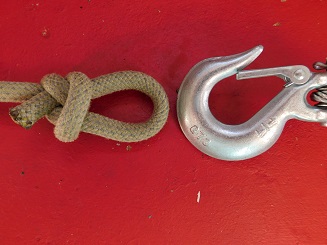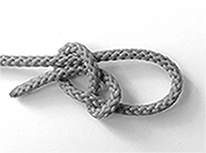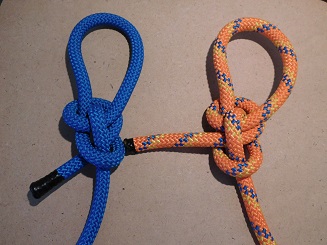Hi guys, I don’t have the time to post much these days, however the image below jumped out at me today in my folder as being useful to anyone who trials knots like I do.
If you are someone who trials knots in expensive materials (eg like either low/long elongation kernmantle/dynamic rope 10-11mm) then being frugal with material used is quite relevant. The knot I show is one I call ‘adjustable’, perhaps only because the deliberate small tail and loop diameter is exactly how I use it (sometimes to 5-6 kN) and I hold the standing part and achieve the shown knot easily. Of course, it does not slip or jam.
I don’t know what the name of knot I use is, however it works. One might argue (as I already have to myself) ‘why not use a standard bowline’? I have done so and for 10-11 dynamic rope a bowline is just fine. In low elongation 10-11mm kernmantle I have more worries with just using a standard bowline… it can fall apart between trials.
That is no big deal perhaps, however I trial a lot of knots. The image I show is currently my favourite for temporary end-loop-rig applications for the reasons given. If you are into acronyms then this knot happens to be PET (post-eye tiable) and TIB (tiable in the bight), neither of which is an important feature in my application.
Cheers,
Ian.

Is this your knot? If so I would call it a slipped figure eight knot.

Hard to discern what your knot is --did Groundline guess
correctly? (A “slipped fig.8” should be just that, and not
this, which isn’t slipped but --what you show in silver–
a fig.8 noose of some sort. “Slipped” refers to having
the final tail tuck being a bight so that one can (in theory
often more than practice!) pull the tail and untie the knot.)
–dl*
I stand corrected on the “Slipped”. Mobius’ is perhaps a jammed figure eight used as a noose.
With a half-hitch around the knot end, Ashley shows it as #187: “The Packer’s Knot”.
Mobius is choosing it for its material economy. I use the packer’ in the garden to bale twigs and cuttings for future burning.
Thanks for the replies. I show two different knots below.
I think the word ‘adjustable’ is a problem in describing these knots. The two images I show below are easy to adjust, simply by holding the standing part and adjusting the round turn returning from the eye. There is a whole thread on “adjustable loops” and many of them are adjustable in the sense of being easy to manipulate, however that is not what adjustable means in (say) the adjustable grip hitch.
The knot in blue is the version I showed in the first post. Create a munter hitch, form an eye and bind the munter with a round turn. Pretty simple and the only thing to watch for is snugging the round turn. Even the tail position in the first knot can be a bit sloppy if you snug the round turn. The second knot (in orange) I show is also one that had a lot of time on my rig in both low and high elongation climbing materials. Both are good knots for what I do with them, knots that do not take much material and do slip or jam are really important to me.
Cheers,
Ian.

I must admit that I have a hard time figuring out
the initial image, and even given the answer have
some challenge --some-- in seeing it there! Thanks
for the clarification.
Have you tried the mytle or bollard loop?
–just form nipping loop and then with tail loop
through this, turning away from eye if poking
through loop from the SPart side (the bowline side)
or towards eye if from the anti-bowline side.
ONE loop (one wraps around the crossing part of
the SPart’s nipping loop) might take some care in
working tight (myrtlep might set more easily than
the other), but I think that these knots can jam a bit
for your purposes.
Give then two wraps w/tail and you can be sure,
at the cost of this extra material.
Another idea, this for a hitch :: make a minimal sort
of timber hitch with a full/round turn on the SPart,
and then a single, well-positioned tuck of the tail!?
–hoping that the full turn adds something to security
(to enable a single tail tuck to work),
as well as to strength!?
You might need to tend to this (noose-)hitch upon initial
loading, if the turn grips and draws away from the
anchor and puts too soon too much demand on the
single tuck to hold --you’d then push back the turn
to the anchor and then continue loading.
A loaded such hitch should cling to the anchor tenaciously,
but you have easy tools to knock loose.
–dl*
I might remind you of this next time I have trouble deciphering one of your knots 
Have you tried the [i]mytle[/i] or [i]bollard loop[/i]?
--just form nipping loop and then with tail loop
through this, turning [u]away from eye[/u] if poking
through loop from the SPart side (the bowline side)
or towards eye if from the anti-bowline side.
ONE loop (one wraps around the crossing part of
the SPart's nipping loop) might take some care in
working tight ([i]myrtlep[/i] might set more easily than
the other), but I think that these knots can jam a bit
for your purposes.
Give then two wraps w/tail and you can be sure,
at the cost of this extra material.
Another idea, this for a hitch :: make a minimal sort
of timber hitch with a full/round turn on the SPart,
and then a single, well-positioned tuck of the tail!?
–hoping that the full turn adds something to security
(to enable a single tail tuck to work),
as well as to strength!?
You might need to tend to this (noose-)hitch upon initial
loading, if the turn grips and draws away from the
anchor and puts too soon too much demand on the
single tuck to hold --you’d then push back the turn
to the anchor and then continue loading.
A loaded such hitch should cling to the anchor tenaciously,
but you have easy tools to knock loose.
–dl*
====
Yes to your suggestions, I’ll try them when I get time. The written word and tying a knot is something I personally have trouble with, though a picture is often just as hard.
Cheers,
Ian


